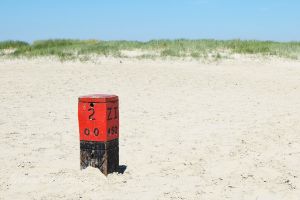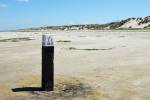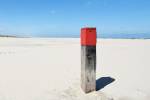Beach pole - Sight



The characteristic and photogenic landmark on the beach: the Beach Posts. Often marked by years of sun, sea, wind, sand, and rain. The popular symbol at the beach for tourists is therefore often depicted on [placename-url] souvenirs such as clothing, artworks, miniatures, and postcards.
Beach Measurements
The first Beach Posts in the Netherlands were placed in 1868 by Rijkswaterstaat. They were used to conduct annual beach measurements: height of the post above the sand, distance from post to dune foot, from post to high-water line, from post to low-water line. The primary purpose of the Beach Posts was the early detection of changes in the beach and dunes along the coastline. If necessary, measures like sand replenishment could be undertaken.
The authentic oakwood posts were 25 cm square, four meters tall, and had an iron band around the red head. In addition to the red-headed and colorless Beach Posts, there are also posts with a white, yellow, and blue head. Numbers are usually engraved on the side, indicating the distance in (kilo)meters between the posts. Originally, the posts were placed every kilometer and protruded one meter above the sand.
In the meantime, the posts have not been used for their original purpose for thirty years. Beach measurements are now done using satellites. These posts now assist cyclists and hikers in orienting themselves along the coast, but they are also indispensable for research, reports, or emergencies, and of course, as a popular photo subject.
For information
Strand
